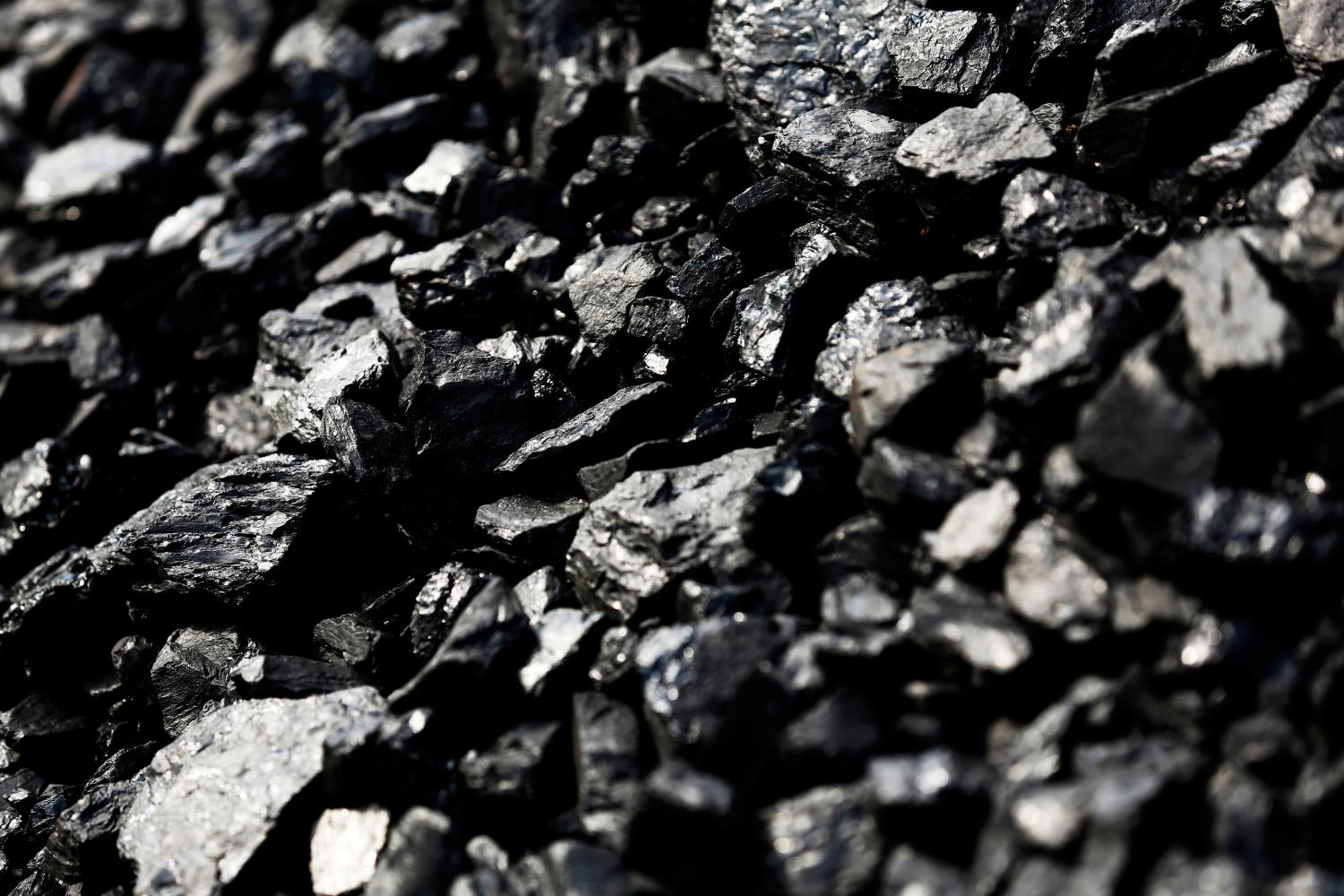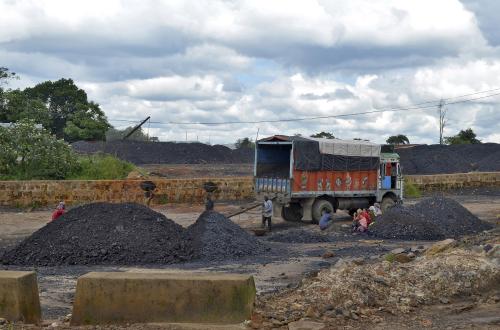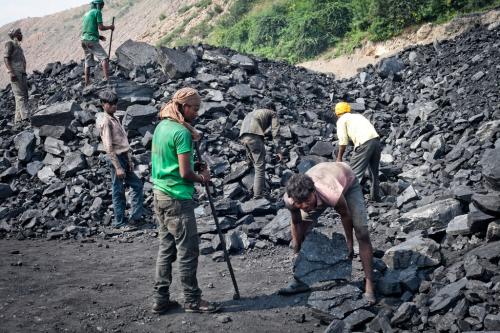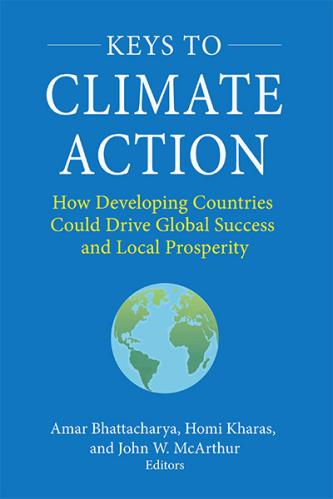Content from the Brookings Institution India Center is now archived. After seven years of an impactful partnership, as of September 11, 2020, Brookings India is now the Centre for Social and Economic Progress, an independent public policy institution based in India.
Brookings India is working on a multi-year study on coal sector in the country. The objective of this research similar is to the objective of India’s coal vision 2030, this is, to identify key coal sector trends, analyse existing policies, and devise suitable frameworks to enable future optimal utilisation of coal for the country.
The Brookings India study also has a slightly broader scope and extends to the ecosystem of coal, to include transportation, electricity (including renewable energy), etc.
Some of our work is already in the public domain and more is under review and will be published soon.
Coal India Limited (CIL) commissioned a study in 2017 to analyse the long term trends that would play a role in determining the future for coal in the country. While commissioning the project, CIL noted, “With government’s efforts to push renewable energy due to international conventions on climate change, increase in carbon cess and other initiatives for lesser use of coal, there is a need for ‘Vision 2030 for the coal sector’, which takes into account the environmental factors such as reduction of carbon footprint, abatement of global warming”.
The report, Coal Vision 2030, addresses some of the key questions for developing a vision for the future of coal and the mega trends shaping it.
Below we give our broad feedback and suggestions on how to improve coal availability in the country and reduce the impact of externalities:
1. Increase production and competition: Leverage higher producing mines to enable more world-scale operations
There is need to liberalise the coal mining regime by providing more autonomy to bigger mines. Coal India Limited’s vision document itself notes that about 15 mines contribute towards half its total coal production. These mines are operated by various subsidiaries, mainly South Eastern Coalfields Limited, Northern Coalfields Limited and Mahanadi Coalfields Limited and exemplify allocation and the subsequent development of large mining blocks.
One of the suggestions for increasing production without breaking CIL into constituent subsidiaries is to develop the large scale operations into independent entities or companies devoid of legacy end-use linkages but with an ability to sell coal in the open market (which is now a reality with commercial mining). This would have the following impact:
- The subsidiaries have a substantial variation as far as the size of their various operational mines is concerned. The relatively large-scale operations, once hived off into independent entities, will have the wherewithal to grow further and can serve as a template for developing future large scale mines.
- Multiple independent large scale operations coupled with the ability to sell competitively priced coal in the open market would promote competition among the largest coal mining entities in the country. The success of these companies could promote future private investment in coal mining in the country.
- Additionally, the experience of these operators would be vital when developing newer deposits or in consolidating smaller blocks into a large-scale coal mining operations which can then be bid out in a block in the future. For the time being the smaller mines (there are 452 such mines in India, producing about 0.6 mtpa per mine) could be left with their existing subsidiaries with a mandate to combine contiguous operations into a consolidated block at a later date.
2. Revisit coal grades pricing mechanism from grades based on coal mined to grades based on coal desired for end use
The upcoming (April 2018) new pricing scheme aims to address intra-grade variation in energy content of coal. However, this change does not address a more fundamental challenge which is inter-grade variation in the price of coal on an energy basis.
Without uniform pricing of energy content, and slippage on delivered grades, consumers struggle to get their feed quality right. However, the price differential between lower grade domestic coal (on unit energy basis and for power generation) leaves sufficient resources to blend coal imports (of higher grades) in order to arrive at the desirable feed quality. The desirable energy basis pricing should benchmark the domestic coal with an appropriate global coal basket to arrive at a backstop for domestic coal pricing.
- Success of coal e-auction exemplifies coal customer’s willingness to pay a premium for exact quality of delivered coal making a stronger case for more liberalised pricing to meet the demands of energy and quality and other characteristics for consumers.
- The additional costs incurred on cleaning and washing run-of-mine coal – which in turns can reduce emissions — should be sufficiently reimbursed in an energy-based pricing, thus incentivising coal washing. Whereas, today’s grade-wise pricing coupled with quality slippage does not leave any incentive to wash coal. However, a price backstop with imported coal may be necessary in this regard, hence the importance of a transparent energy benchmark for coal pricing.
- Energy pricing would also introduce price efficiency in coal transportation by reducing dead weight costs of carrying ash through various modes.
3. Increase market participation and ability to raise finances: With a competitive coal mining sector in the country, the ability to raise competitive finance should also improve
International investment in domestic coal mining is contingent with a liberalised regime for exploration and development of coal blocks. Although 100 per cent foreign direct investment is allowed in this sector, investment is limited due to restrictions on exploration and development of a coal block. This policy structure needs to be reconsidered in light of sector specific requirement of a risk capital for investment. Moving forward, there needs to be a HELP-like policy (hydrocarbon exploration and licensing policy) for a unified licence for all coal operation types (coalbed methane, coal to Liquid, coal gasification and mining) with suitable risk sharing/pooling mechanisms. Additionally, an easy entry and exit for companies in this space at all levels including exploration and junior miners would promote future investment.
4. Coal mining needs to be facilitated with offtake routes for bulk transportation over long distances: with railways projects delayed for long periods of time it is imperative to look at alternatives
Logistics availability and co-ordination in offtake arrangements for coal through railways needs dedicated private lines to be built in areas where future mining capacity will come up. The Indian Railways continues to be resource constrained hence private investment through either a build-own-operate or a build-own-operate-transfer model in addition to customer-owned merry-go-round systems may be looked at for speedy execution of projects to ensure logistical connectivity.
5. Risk is the biggest challenge and risk management needs new instruments, contracting, and incentives
The coal sector has long lead times and lifespans, whether we consider mines, railways, or even power plants. Predictions on electricity demand are themselves uncertain, let alone coal demand (which is a falling share of the electricity mix). Flexibility in the power market is recognized as a need (e.g., power markets instead of rigid power purchase agreements that do not reflect grid conditions such as time of day pricing) – is there an analogy for coal? What happens if a coal power plant does not find offtake (plant load factor or PLF) as originally envisaged? Who bears that exposure?
At one extreme would be perfect contracting, where the miner promise to produce X tonnes, deliver it for Y price, etc. The power plant is also sure of a corresponding Z PLF. The reality is that if anything in this relationship drifts, there is a cost implication (especially to cover fixed costs). Who should bear that risk? If instruments are too restrictive, e.g., take or pay, this will further disincentivise contracts for coal-based power which is facing growing uncertainty from RE, more so after a few years when battery technologies would allow competition with coal as a baseload and despatchable (on-demand) source of power.
Brookings India scholars’ comments on specific sections of the Coal Vision Document 2030
1. Strong growth in domestic coal production albeit lower than the demand growth (Section 1.2)
CIL report suggests: “… dependence on the import of coal reduced…”
Sehgal, Tongia: Coal imports have reduced in the past year due to multiple reasons not attributable to export substitution alone. There was a simultaneous increase in CIL production in the year 2015-16 however, the pace of this increase has since reduced. Importantly though, the reduction in imports cannot be inferred as a long-term trend since domestic production remains a fall back in lieu of higher demand when CIL has struggled to fulfill its own coal production in the current fiscal (FY’17-18).
2. Renewables and storage likely to emerge as key substitutes (Section 2.1)
CIL report suggests: “This may have significant implications on coal-fired power plants in terms of replacing the thermal capacity required to meet the peak ”
Sehgal, Tongia: NO – coal was never a peak-oriented plant, rather baseload. What storage would add for RE is ability to be despatchable and also offer supply at non-coincident periods. If one really needed peak power, one would not build a coal plant but rather something economic with just 2 hours per day usage, like gas.
3. Renewables and storage likely to emerge as key substitutes (Section 2.1)
CIL report suggests: Figure on battery plus solar costs, sources US DoE and KPMG analysis
Sehgal, Tongia: These are opaque and whimsical calculations. At $100/kWh, how is solar plus battery so expensive? Yet, halving capex of batteries MORE THAN halves the overall Rs/kWh.
4. Energy efficiency to be another key substitute (of energy demand, and thereby coal demand) (Section 2.2)
CIL report suggests: “Electricity intensity of GDP has fallen for India from 1.8 to 1.2”
Sehgal, Tongia: These are VERY outdated numbers – the figure has been 1 for many years, and now is under 1 (unless things change, which are a few years away). “Rural electrification” will not add much demand until rural incomes rise, and Make in India is focussing on value-add manufacturing instead of natural resource base (energy intensive) industry.
5. Regulatory environment to continue to get stricter, increasing the compliance cost (Section 2.4)
CIL report suggests: INR 0.20–0.30 per kWh as cost of MoEFCC compliance
Sehgal, Tongia: These are on the LOW end of numbers calculated, and some entities *claim* costs can be far higher.
6. Extant coal to liquid technologies find limited fitment with Indian coal; focussed implementation and fiscal support required to drive the opportunity (Section 2.5)
CIL report suggests: “coal to chemical technologies have the potential to grow in to 90–120MTPA of coal demand by 2030”
Sehgal, Tongia: This is speculative partly, and using these feeds in lieu of oil & gas has a higher carbon implication as well.
7. Technology adoption by the coal sector in India is limited (Section 3.2)
CIL report suggests: “about 50% of CIL’s total production comes from 15 mines (all opencast) having a total production 279 MTPA”
Sehgal, Tongia: Technology adoption is held up for want of large-sized mines as evidenced from the statement, however, the legacy of non-mechanised mining in older mines has given rise to social structures that inter alia prevent large scale technology adoption.
The policy of demarcating smaller blocks to diversify operational risk into multiple mining agencies not only blocks coal in barriers but limits scale of operations too. It is important to leverage the large scale operations in the country (15 mines producing 279 MTPA) to become more independent and eventually given access to consolidated coal deposits for future mining instead of the current structure of coal mining by 7 subsidiaries. However, this would only work if the sale of coal is also liberalised for end use.
8. Favourable cost structure (Section 3.4)
CIL report suggests: “It is estimated that the average cost of production (ROM coal, excluding crushing, sizing, transportation charges and all levies, duties, cess) is about INR 1,000 per tonne”
Sehgal, Tongia: This is a bit on the higher side, and varies heavily by mine and its overburden (stripping ratio). NOTE, this is not necessarily an absolute, as US Western coal (PRB) retails around $10/short tonne.
9. Coal demand growth in non-regulated sector to be higher than regulated sector (power) (Section 5.2)
CIL report suggests: “The coking coal demand from the sector is estimated to increase to 140-160 MTPA by 2030 as against the current demand level of 60-70 MTPA.”
Sehgal, Tongia: Coking coal should be a key sector of concern with only ~4 MTPA of current annual demand being fulfilled by domestic coal supply. Also, Australia has a dominant monopolistic position in the met coal market while India is a minor player compared with Japan and China. Indian steel sector growth would be hostage to higher prices unless the JAP (Jharia Action Plan) moves at a faster pace and or newer deposits are explored. With the proposed Carmichael coal mine facing multiple problems in execution, amidst an anti coal sentiment prevalent across the world it would be tough for India to own a (low risk/riskless) coal mine in Australia (or other countries). A combination of select focus on coking coal mining and coal washing/quality enrichment can solve some of these problems however, the usage of coking coal in power sector does not inspire much hope for reversing this trend in the near future.
10. No new coal mines need to be allocated/auctioned beyond the current pipeline (Section 5.3)
CIL report suggests: Figure showing 1 BT plan by CIL (BY 2020?)
Sehgal, Tongia: The 1 billion tonne plan is an exaggeration of demands and capabilities of production from CIL in the given time frame as we have clearly made a case for in our paper on demand estimates for 2020 coal in India.
11. Captive coal blocks may be underutilised due to issues of end consumer sectors (Section 5.6)
CIL report suggests: “Therefore, it is estimated that the production from this segment can be constrained to 270-325 MTPA from the blocks allocated till date as against the total capacity of 500 MTPA”
Sehgal, Tongia: This is the most risky part of the bet as far as coal production is concerned, the captive blocks are of course contingent to approvals and local land and social issues however, it is very difficult to put an accurate estimate of the actual production expected from this segment. This sector has been constrained for multiple reasons and there seem to be no urgency to comprehensively address issues relating to administrative and regulatory and policy bottlenecks.
12. Logistics infrastructure is likely to emerge as a key bottleneck (Section 5.7)
CIL report suggests: “Since the gestation period for railways projects are longer, it is recommended that long term planning is undertaken and key infrastructure facilities are implemented”
Sehgal, Tongia: Railways speed of development has been slow, with several projects like DFC running behind schedule. In the future, with a plausible rationalization on coal linkages (linked with merit order pricing of power and other reforms) and development of pit head power plants the future earnings growth of railways could be severely curtailed. Coal contributes the highest to railways revenue, and with a reduction in revenue railways may have to raise prices, backstopped with the competing modes of coal transportation, e.g., trucks.
13. Focussed strategy to coal production is required to drive sustainable growth (Section 6.1)
CIL report suggests: “Beyond 1,300 MTPA, the aspiration towards 1,900 MTPA has to be fulfilled in parts.”
Sehgal, Tongia: 1900 MTPA requirement seems to be too high, what does this number imply on a temporal frame?
Low cost production capacity (Section 6.2)
CIL report suggests: “Historically, coal mining companies have invested lesser in R&D for carbon sequestration and other clean coal technologies in comparison to power utility companies”
Sehgal, Tongia: Clean coal represents a spectrum of environmental impacts and technologies. Which solutions are appropriate depend on an explicit or implicit value to the externalities. The short-run focus should be on coal power plant emissions reductions, to meet the Ministry of Environment, Forests and Climate Change (MoEFCC) norms well in advance of the (now extended) deadline. CIL’s role in this is to have appropriate grades and qualities of coal, with consistency, that encourages more efficient combustion and easier environmental clean-up. Also, multiple (global) studies have estimated a very high cost to carbon capture and sequestration, leaving little role for miners in this part of the coal chain.
14. Create an enabling flexibly coal allocation policy (Section 6.3)
CIL report suggests: “create an enabling policy that provides flexibility to the coal sector to deal with the uncertainties that are looming in the future”
Sehgal, Tongia: The importance of allowing coal companies to fix their sectoral allocation and preferential treatment for coal allocations cannot be over emphasised.
Coal companies should be allowed to sell coal as per the requirements of their customers (quality) and costs of transportation. As of now, the monopoly position of Coal India Limited and other companies make them focused on production without appropriate heed to the quality and other requirements of consumers.










